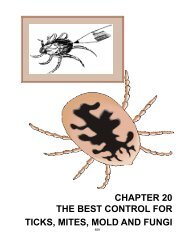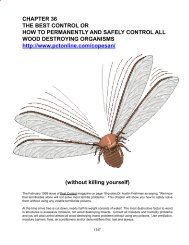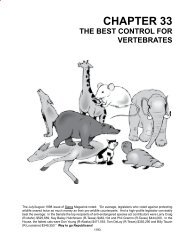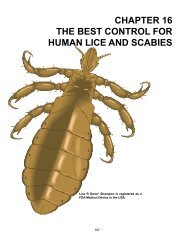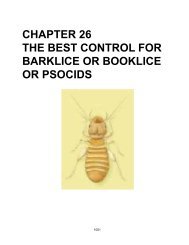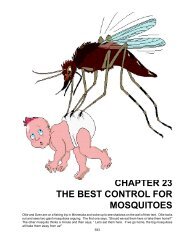CHAPTER 11 - The Best Control 2
CHAPTER 11 - The Best Control 2
CHAPTER 11 - The Best Control 2
- No tags were found...
Create successful ePaper yourself
Turn your PDF publications into a flip-book with our unique Google optimized e-Paper software.
elderberry leaves to protect them from insects and disease. See Plant Product Insecticides and/or Fungicides.Electric Fence - A single strand of electric wire 4” - 6” off the ground should put an end to virtually any animalpest invasions, except deer (as they may easily jump over the barrier).Electricity - <strong>The</strong>re are electrocuting rat traps, electro-guns and electrical bird repellents, etc.Electrocuting Insect Traps - Use these with great discretion because we have a great concern about the dangerof disease-causing viruses surviving on the insect parts that explode from these units.Eliminate Competition - Remove weeds and grass from the growing site since they compete for nutrients andwater.Encarsa formosa - are not native to North America. <strong>The</strong>se wasps are sold to prey on greenhouse whitefliesand sweet potato whiteflies.Encasement - Encasement of the mattress and box spring will deny bed bugs access to inner and hard to reachareas. Bed bugs have been surveyed and 90% of the infestation is found living inside beds, sofas and/or recliningchairs, so encasing these objects will kill all bed bugs living inside and will prevent others from infesting insidethese tightfitting covers. You can also see any remaining bed bugs on these covers more easily. Use a quality,zippered bed (dust mite) encasement cover.Endophytes - are fungi that infect some grasses and live symbiotically in the leaves. <strong>The</strong>y benefit the grassby producing toxins that kill and repel insects and confer some disease resistance. Turfgrass varieties withendophytes are generally more vigorous, more tolerant of heat and drought and more competitive than the samevarieties without endophyte infections. Several varieties of perennial ryegrass and fescues with high levels ofendophyte infections are now available from turf seed suppliers. When buying, check the lot numbers to makesure seed is fresh because the endophytes may die after prolonged storage even though the grass seed itselfremains viable. Do not plant endophyte infected grasses where horses or other livestock might reach it as theendophytes are harmful to grazing animals.Entomopathogenic Fungi - Several mold fungi are natural insecticides and will kill insects and use their deadbodies to launch spores. <strong>The</strong>se spores can be used to repel and/or kill ants, termites, flies, crickets and grasshoppers.Enzyme Cleaners - <strong>The</strong> 5th Edition of Truman’s Scientific Guide to Pest <strong>Control</strong> Operations described “<strong>The</strong>Ideal Pesticide”. “Ideally any pesticide will act rapidly on pests, yet be completely harmless to people, domesticanimals, wildlife, and other aspects of the environment. Its residues would only last as long as was necessaryto create the desired effect, usually for very short periods. It would also be inexpensive and readily available innecessary quantities, chemically stable (before application), non-flammable, and otherwise safe to use aroundhomes or industrial sites. It would be easily prepared and applied, non-corrosive and non-staining, and it wouldhave no undesirable odor. Unfortunately, no such (synthetic) pesticide exists.” Purdue University and AdvanstarCommunications (Pest <strong>Control</strong> Magazine) worked on this 1997 Pest <strong>Control</strong> Manual, but they were, obviously,still unaware the Author had begun patenting and using and field testing the perfect (pesticide) or Pestisafe ®based on natural pest control. In addition to being on the (perfect pesticide poison descriptive) list, Safe SolutionsTweetmint enzyme cleaners, shampoos or soaps with enzymes will never create any pest resistance problems,are truly the perfect “pesticides” and the entire compounds contain only ingredients that are considered non-toxicor GRAS (Generally Recognized as Safe) and they are active as long as they are liquid and can be used virtuallyeverywhere, even when people are sick, under 1, over 60, pregnant and/or chemically sensitive to controleven pesticide-resistant pests. In addition, these Safe Solutions, Inc. products can be diluted/applied in sucha way that only the pest species are killed, leaving the beneficial species alive! <strong>The</strong> U. S. EPA prohibits any/all claims that any registered pesticide poison is either safe or non-toxic. That is just another reason why wecall enzyme cleaners, soaps and shampoos natural biological controls and/or Pestisafes ® rather than pesticidepoisons. Maggots produce enzymes to help soften up their food so they can eat it. Insectivore plants produceand also use protease enzymes to digest their insect prey. Spiders and scorpions produce and inject proteaseenzymes to predigest their prey and all molting insects produce a small amount of protease enzyme to serveas a chemical “zipper” so they can split open their exoskeletons when they molt and increase twice their size;385



